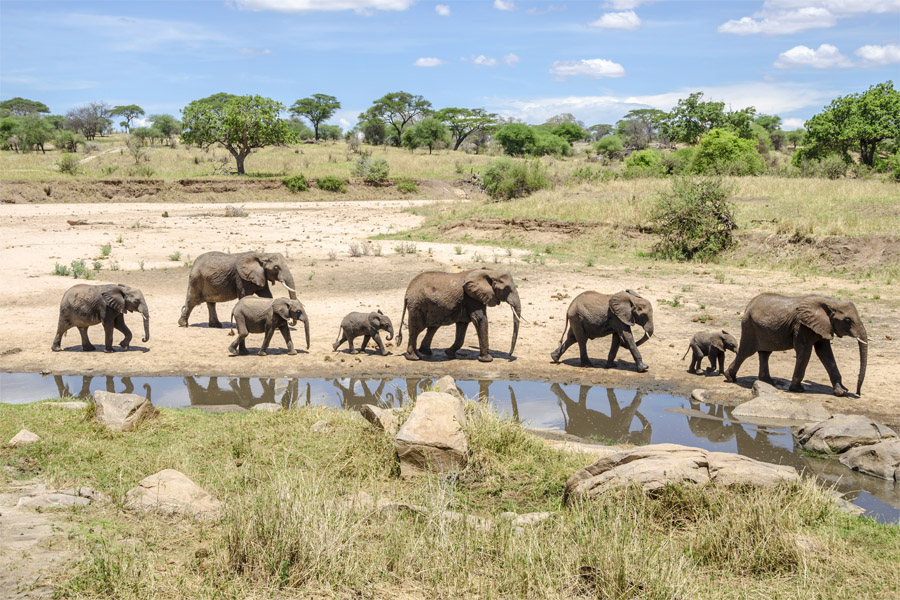Tarangire National Park, Tanzania
🌳 Tarangire National Park: Baobab Kingdom and Elephant Wonderland
Nestled in northern Tanzania’s safari circuit, Tarangire National Park is often overshadowed by its more famous neighbors like Serengeti and Ngorongoro. But for those in the know, Tarangire is a hidden gem, revered for its colossal baobab trees, epic elephant gatherings, and a more tranquil, uncrowded safari experience. This underrated park offers some of Africa’s richest wildlife experiences wrapped in a setting of wild beauty and ancient grandeur.
🐘 Wildlife Highlights: Where Elephants Reign Supreme
Tarangire is home to one of the largest concentrations of elephants in East Africa. During the dry season (June–October), thousands of them converge around the Tarangire River, the park’s lifeline, creating awe-inspiring scenes of family herds bathing, feeding, and playing.
🦁 Predators and Big Game
In addition to elephants, Tarangire is home to lions, leopards, cheetahs, and hyenas. Though sightings can require patience, the lack of crowds offers a more intimate wildlife encounter.
🦓 Plains Full of Grazers
You'll find zebras, giraffes, wildebeests, impalas, and the elusive fringed-eared oryx roaming the grasslands. The rare greater kudu—with its magnificent spiraled horns—is also spotted here more often than in other parks.
🐦 A Birder’s Paradise: Over 550 Species Await
If you’re a bird lover, Tarangire is pure heaven. With over 550 species, including yellow-collared lovebirds, hornbills, lilac-breasted rollers, bustards, and vultures, it ranks among the top birdwatching spots in Tanzania. The lush wetlands attract flocks of waterbirds, especially near Silale Swamp, which acts as a year-round water source for both birds and animals.
🌲 Landscapes of Drama and Diversity
Tarangire is known for its signature baobab trees, some of which are over 1,000 years old. These ancient giants dot the landscape like natural monuments, creating a surreal and majestic backdrop.
🌾 Rivers, Hills & Swamps
The winding Tarangire River carves through the park’s dry terrain, drawing wildlife from every direction. To the south, vast seasonal swamps and acacia woodlands offer different habitats and photography scenes. The terrain is more varied than the Serengeti, with rolling hills, dramatic skies, and dust-kissed sunsets that seem straight out of a painting.
🚗 Getting There: Seamless Safari Access
Located in the heart of the northern safari circuit, Tarangire is easy to reach and perfect for combining with other parks like Lake Manyara, Ngorongoro, or even Arusha National Park.
📍 Distance from Arusha:
-
Around 120 km (2–3 hours by road)
-
Can be reached by private vehicle or organized safari tours
-
Small aircraft flights available to Kuro Airstrip inside the park
🛖 Where to Stay: From Rustic Camps to Luxury Lodges
Tarangire offers a mix of authentic safari camps, luxurious eco-lodges, and budget-friendly options, many of which are nestled among the baobabs or overlooking animal paths and watering holes.
🌟 Top Picks Include:
-
Tarangire Treetops Lodge – Luxury treehouse living in the heart of the bush
-
Tarangire Safari Lodge – Spectacular cliffside views and classic safari ambiance
-
Ndovu Tented Lodge – Comfortable mid-range tented experience
-
Public campsites – For budget travelers and adventurers
📅 Best Time to Visit: Wildlife Concentration at Its Peak
Tarangire shines brightest during the dry season (June to October) when wildlife congregates along the river. During this time, animal sightings are dense, and the chances of witnessing large elephant herds and predator-prey interactions are high.
🌦️ Seasonal Breakdown:
-
June–October: Best for wildlife viewing; dry, clear, and active
-
November–May: Lush landscapes, excellent for birdwatching, but wildlife is more dispersed
-
March–April: Rainy season—not ideal for game drives due to slippery roads
🧭 Why Visit Tarangire National Park?
Tarangire offers something that the more tourist-heavy parks often can't: serenity, intimacy, and a slower pace. It’s where the drama of nature unfolds without the distraction of dozens of other safari vehicles.
From the gentle rumble of elephant herds crossing dusty roads to the quiet wonder of watching birds soar above baobabs at sunset, Tarangire is a deeply soulful safari destination. Whether you visit as part of a broader Tanzanian itinerary or devote extra days here, you’ll leave with a sense of having discovered a true African secret.


